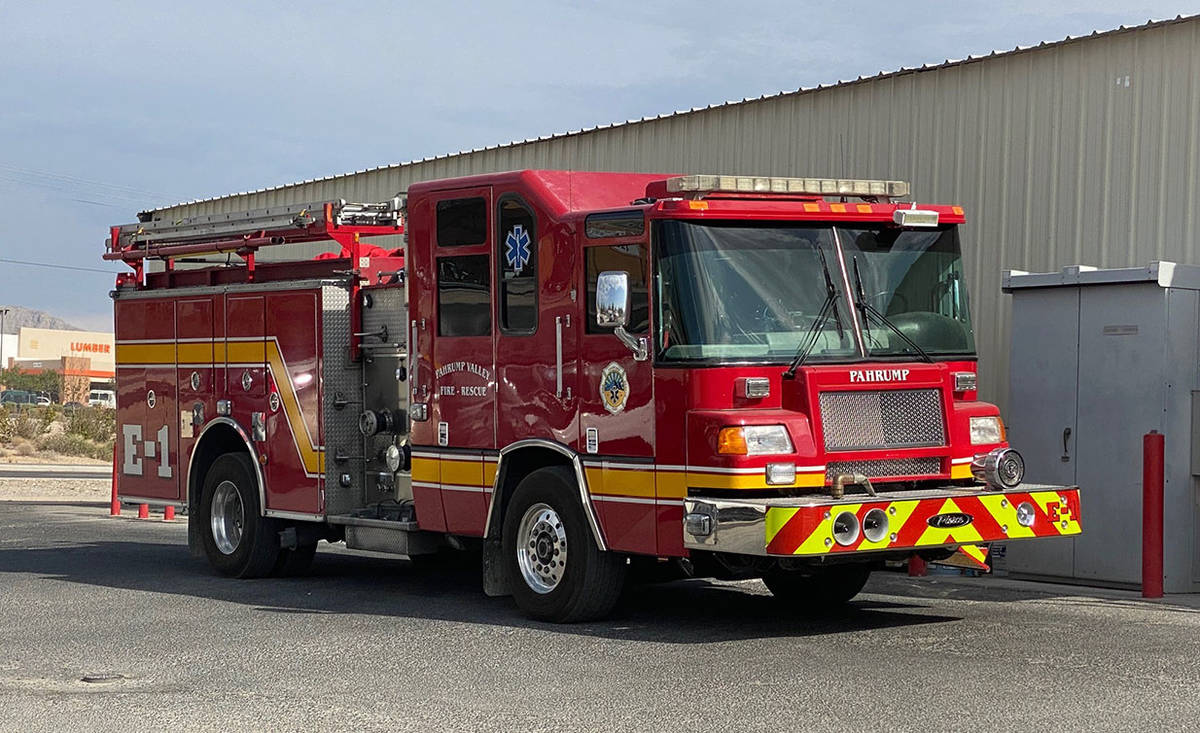
Pahrump Valley Fire and Rescue mobilized to assist in the fight against the Caldor Fire that was still threatening South Lake Tahoe on Thursday.
Pahrump Valley Fire and Rescue (reserve) Engine 1 was requested and assigned to respond to the now more than 210,000-acre blaze in the northern half of the state on Monday as part of a strike team of Type 1 engines, according to a release from Nye County.
“Pahrump Valley Fire has partnered with Las Vegas Fire &Rescue, Clark County Fire Department, and North Las Vegas Fire Department to form the strike team,” Nye County Public Information Officer Arnold Knightly said in an email.
Those crews were tentatively assigned to structure protection in the areas of Incline Village and Tahoe Douglas, Knightly said in the Monday email.
A team of four was mobilized early in the week for a 14-day deployment. The team consisted of a member of Nye County Emergency Management, a volunteer firefighter from the Pahrump Valley, a Pahrump Valley firefighter/paramedic and a Pahrump Valley firefighter/advanced emergency medical technician.
The team was scheduled to deploy on Monday.
On Monday, Gov. Steve Sisolak declared a state of emergency over the wildfire.
“On behalf of the state of Nevada, I would like to thank all of our brave first responders, local government agencies, and nonprofit entities who continue to go above and beyond to assist our communities during the Caldor Fire,” Sisolak said in a press release. “We will continue to use all our available resources to fight this fire and assist those in need.”
According to Sisolak’s release, by declaring the state of emergency, it ensures that resources from local, state and at the federal level are available to assist the situation that are needed.
On Tuesday, areas along or near Lake Tahoe in Douglas County were put under a mandatory evacuation order. The order follows Gov. Steve Sisolak declaring a state of emergency in response to the Caldor Fire.
As of midday on Thursday, crews had kept the fire from advancing on populated areas or the lake. The wildfire had burned 210,259 acres on early Thursday and was at 25% containment.
Crews were assisted with calmer winds and moderate humidity in some areas on Wednesday night, but spotting and fire spread still occurred along the northern edge of the fire, according to CalFire.
Firefighters planned to work on bolstering lines on Thursday, “where large pockets of previously unburned fuel threaten existing control lines,” a CalFire update stated.
As of Thursday, 4,451 personnel were fighting the Caldor Fire that has destroyed over 600 homes and is threatening 32,387 structures. Three first responders have been injured in the wildfire and two civilians were injured, according to a 7 a.m. update from CalFire.
CalFire has an expected containment date of Sept. 13. The fire started in Grizzly Flats in California on Aug. 14 about 35 miles southwest of South Lake Tahoe. As it came within a few miles of South Lake Tahoe, evacuations were ordered in California and in Nevada.
With strained firefighter resources and public and firefighter safety with the extreme conditions, the USDA Forest Service Pacific Southwest Region announced the temporary closure of all national forests in California.
Smoke pollution in Nye
Smoke from the Caldor Fire reached the northern portion of Nye County this week, but it was set to roll out on Friday.
By Friday, the smoke could start to calm, depending on wind conditions, said Daniela Pirraglia, a meteorologist at the National Weather Service in Elko.
“But based on what we’re expecting in terms of the winds, it looks like there’s a good chance for some improvement on Friday,” Pirraglia said.
Pirraglia said that a sustained southward wind is what Tonopah needs for the smoke to clear out.
Because the Caldor Fire is burning to the west of Reno, northwest winds make for favorable conditions for the smoke to pool in Tonopah.
“When your winds start coming out of the south or the southwest, because of where the fire’s burning, that actually blows it away from Tonopah,” Pirraglia said. “The problem is getting that wind direction to stick around long enough to have an opportunity to filter out that smoke.”
As for the weekend in Tonopah, there still could be smoke lingering in the air, which could affect the air quality for locals, though most will blow out at the end of the week.
Pirraglia said, “As long as these fires are burning in California, it’s going to be difficult to get those clear blue skies a lot of us miss.”